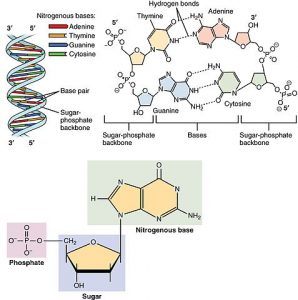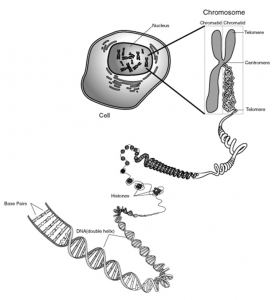1.2 DNA Overview
All living things have genetic material that they pass on to their offspring. This genetic material, deoxyribonucleic acid, or DNA, contains a code that serves as the blueprint for building each unique organism. In humans, and many other organisms such as plants and fungi, DNA is housed in a membrane-bound organelle called a nucleus. Every cell in your body contains a complete copy of the DNA instructions for building all of the parts of your body. This complete copy is referred to as your genome. Unless you have an identical twin, your genome is unique.
Despite their identical DNA, your body cells can be very different from each other. For example, the cells lining the inner surface of your cheek have a different structure and function than do the cells that make up the cheek muscles that allow you to smile. This is because each cell uses only a subset of the DNA instructions to make the specific proteins that it needs.
DNA structure
DNA is a macromolecule made up of a string of smaller units called nucleotides. Each nucleotide is made up of a sugar, a phosphate group and a base (Figure 1).

There are four different possible bases, adenine, thymine, cytosine and guanine. It is the order of these bases (often referred to simply as As, Ts, Cs and Gs) which make up the DNA “code.” DNA is found in the nuclei of all human cells, and serves as the blueprint for the production of the proteins necessary to maintain life.

Human DNA is organized into 23 pairs of chromosomes (Figure 2). Before a cell divides, it replicates its DNA so that both daughter cells have a complete copy of the DNA blueprint. Occasionally, errors are made in DNA replication. Because the order of base pairs determine the proteins a cell makes, these errors, if left uncorrected, can lead to the production of different proteins. Errors in DNA replication that result in changes in the DNA molecule are called mutations. Mutations can happen in the DNA of any cell in the body. If a mutation happens in a sex cell, which is responsible for makings gametes (sperm or eggs), that mutation could be passed on to the organism’s offspring. This videoclip offers a brief overview of the organization of human DNA and how small variations in human DNA caused by mutations can result in the variation we see in human populations.

